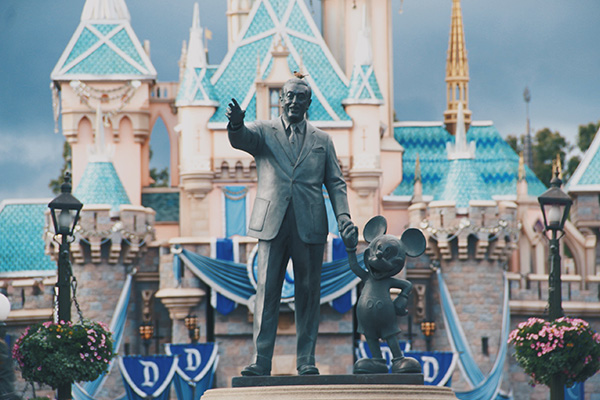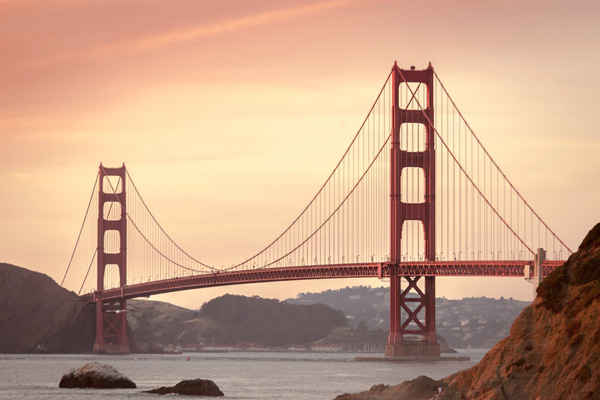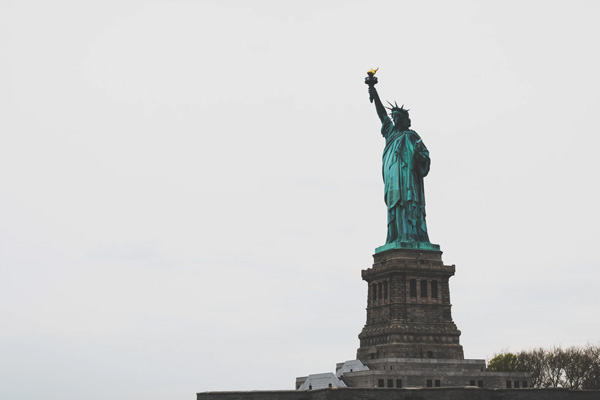Moving ToUnited States
Points of Interest

WALT DISNEY WORLD

CENTRAL PARK

GOLDEN GATE BRIDGE

STATUE OF LIBERTY
HISTORY
The arrival of Christopher Columbus in 1492 started the European colonization of the Americas. Most colonies formed after 1600. By the 1770s, thirteen British colonies contained 2.5 million people along the Atlantic coast east of the Appalachian Mountains. After defeating France, the British government imposed a series of new taxes after 1765, rejecting the colonists’ argument that new taxes needed their approval (see Stamp Act 1765). Tax resistance, especially the Boston Tea Party (1773), led to punitive laws by Parliament designed to end self-government in Massachusetts. Armed conflict began in 1775. In 1776, the Second Continental Congress declared a new, independent nation: the United States of America. Led by General George Washington, it won the Revolutionary War with large support from France.
The United States became the world’s leading industrial power at the turn of the 20th century due to an outburst of entrepreneurship in the Northeast and Midwest and the arrival of millions of immigrant workers and farmers from Europe. Initially neutral during World War I, the United States declared war on Germany in 1917 and funded the Allied victory the following year.
ECONOMY
The United States has a capitalist mixed economy which is fueled by abundant natural resources and high productivity. According to the International Monetary Fund, the U.S. GDP of $16.8 trillion constitutes 24% of the gross world product at market exchange rates and over 19% of the gross world product at purchasing power parity (PPP). The U.S. dollar is the currency most used in international transactions and is the world’s foremost reserve currency, backed by its science and technology, its military, the full faith of the U.S. government to reimburse its debts, its central role in a range of international institutions since World War II and the petrodollar system.
Government & Politics
The United States is a federal republic in which the president, Congress, and federal courts share powers reserved to the national government according to its Constitution. The federal government shares sovereignty with the state governments.Two political parties, the Democratic Party and the Republican Party, have dominated American politics since the American Civil War, although smaller parties exist such as the Libertarian Party, the Green Party, and the Constitution Party. Generally, the Democratic Party is commonly known as the left-wing party within the United States, while the Republican Party is commonly known as the United States’ right-wing party.
Geography
The term “United States”, when used in the geographical sense, is the contiguous United States, the state of Alaska, the island state of Hawaii, the five insular territories of Puerto Rico, Northern Mariana Islands, U.S. Virgin Islands, Guam, and American Samoa, and minor outlying possessions. The United States shares land borders with Canada and Mexico and maritime borders with Russia, Cuba, and the Bahamas in addition to Canada and Mexico. The United States’s northern border with Canada is the world’s longest bi-national land border.
Start your journey today!
Culture

Arts
VISUAL ARTS
The Hudson River School was a mid-19th-century movement in the tradition of European naturalism. The realist paintings of Thomas Eakins are now widely celebrated. The 1913 Armory Show in New York City, an exhibition of European modernist art, shocked the public and transformed the U.S. art scene. Georgia O’Keeffe, Marsden Hartley, and others experimented with new, individualistic styles. Major artistic movements such as the abstract expressionism of Jackson Pollock and Willem de Kooning and the pop art of Andy Warhol and Roy Lichtenstein developed largely in the United States.
LITERATURE
Writers such as Nathaniel Hawthorne, Edgar Allan Poe, and Henry David Thoreau established a distinctive American literary voice by the middle of the 19th century. Mark Twain and poet Walt Whitman were major figures in the century’s second half; Emily Dickinson, virtually unknown during her lifetime, is now recognized as an essential American poet. A work seen as capturing fundamental aspects of the national experience and character—such as Herman Melville’s Moby-Dick (1851), Twain’s The Adventures of Huckleberry Finn (1885), F. Scott Fitzgerald’s The Great Gatsby (1925) and Harper Lee’s To Kill a Mockingbird (1960)—may be dubbed the “Great American Novel”.
FILM
Hollywood, a northern district of Los Angeles, California, is one of the leaders in motion picture production.
The major film studios of Hollywood are the primary source of the most commercially successful and most ticket selling movies in the world, such as The Birth of a Nation (1915), Gone with the Wind (1939), The Ten Commandments (1956), The Sound of Music (1965), Jaws (1975), Star Wars (1977), E.T. the Extra-Terrestrial (1982), Jurassic Park (1993), Titanic (1997), The Dark Knight (2008), Avatar (2009), The Avengers (2012) and Star Wars: The Force Awakens (2015). Moreover, many of Hollywood’s highest-grossing movies have generated more box-office revenue and ticket sales outside the United States than films made elsewhere. Today, American film studios collectively generate several hundred movies every year, making the United States one of the most prolific producers of films in the world and a leading pioneer in motion picture engineering and technology.
MUSIC
The country’s most internationally renowned genres are jazz, blues, country, bluegrass, rock, rhythm and blues, soul, ragtime, hip hop, barbershop, pop, experimental, techno, house, dance, boogaloo, salsa, and rock and roll. The United States has the world’s largest music market with a total retail value of 4,898.3 million dollars in 2014, and its music is heard around the world. Since the beginning of the 20th century, some forms of American popular music have gained a near global audience.
Elvis Presley and Chuck Berry were among the mid-1950s pioneers of rock and roll. Rock bands such as Metallica, the Eagles, and Aerosmith are among the highest grossing in worldwide sales. In the 1960s, Bob Dylan emerged from the folk revival to become one of America’s most celebrated songwriters and James Brown led the development of funk.
More recent American creations include hip hop and house music. American pop stars such as Prince, Michael Jackson, and Madonna have become global celebrities, as have contemporary musical artists such as Taylor Swift, Britney Spears, Katy Perry, Beyoncé, Jay-Z, Eminem and Kanye West.

Media
The four major broadcasters in the U.S. are the National Broadcasting Company (NBC), Columbia Broadcasting System (CBS), the American Broadcasting Company (ABC), and Fox. The four major broadcast television networks are all commercial entities. Cable television offers hundreds of channels catering to a variety of niches. Americans listen to radio programming, also largely commercial, on average just over two-and-a-half hours a day. Well-known newspapers include The Wall Street Journal, The New York Times, and USA Today.

Cuisine
Mainstream American cuisine is similar to that in other Western countries. Wheat is the primary cereal grain with about three-quarters of grain products made of wheat flour and many dishes use indigenous ingredients, such as turkey, venison, potatoes, sweet potatoes, corn, squash, and maple syrup which were consumed by Native Americans and early European settlers. These homegrown foods are part of a shared national menu on one of America’s most popular holidays; Thanksgiving, when some Americans make traditional foods to celebrate the occasion.
Characteristic dishes such as apple pie, fried chicken, pizza, hamburgers, and hot dogs derive from the recipes of various immigrants. French fries, Mexican dishes such as burritos and tacos, and pasta dishes freely adapted from Italian sources are widely consumed. Americans drink three times as much coffee as tea. Marketing by U.S. industries is largely responsible for making orange juice and milk ubiquitous breakfast beverages.
The American fast food industry, the world’s largest, pioneered the drive-through format in the 1940s. Fast food consumption has sparked health concerns. During the 1980s and 1990s, Americans’ caloric intake rose 24%; frequent dining at fast food outlets is associated with what public health officials call the American “obesity epidemic”. Highly sweetened soft drinks are widely popular, and sugared beverages account for nine percent of American caloric intake.

Sports & Recreations
American football is by several measures the most popular spectator sport; the National Football League (NFL) has the highest average attendance of any sports league in the world, and the Super Bowl is watched by millions globally. Baseball has been regarded as the U.S. national sport since the late 19th century, with Major League Baseball (MLB) being the top league. Basketball and ice hockey are the country’s next two leading professional team sports, with the top leagues being the National Basketball Association (NBA) and the National Hockey League (NHL).













